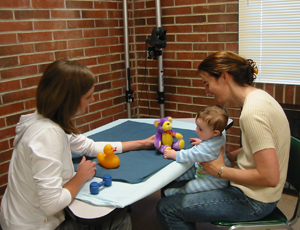Using a brain-imaging technique that examines the entire infant brain, researchers have found that the anatomy of certain brain areas – the hippocampus and cerebellum – can predict children's language abilities at 1 year of age.
 The University of Washington study is the first to associate these brain structures with future language skills. The results are published in the January issue of the journal Brain and Language.
The University of Washington study is the first to associate these brain structures with future language skills. The results are published in the January issue of the journal Brain and Language.
"The brain of the baby holds an infinite number of secrets just waiting to be uncovered, and these discoveries will show us why infants learn languages like sponges, far surpassing our skills as adults," said co-author Patricia Kuhl, co-director of the UW's Institute for Learning & Brain Sciences.
Children's language abilities soar after they reach their first birthdays, but little is known about how infants' early brain development seeds that path. Identifying which brain areas are related to early language learning could provide a first glimpse of development going awry, allowing for treatments to begin earlier.
"Infancy may be the most important phase of postnatal brain development in humans," said Dilara Deniz Can, lead author and a UW postdoctoral researcher. "Our results showing brain structures linked to later language ability in typically developing infants is a first step toward examining links to brain and behavior in young children with linguistic, psychological and social delays."
Read the Full Press Release.